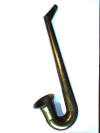Zobo and Songophone
The Zobo saxophone dates from the end of the 19th century. Under the Zobo brand W.H. Frost in New York marketed a whole line of brass kazoo's from 1895 onwards. On Januar 7th, 1896 he had the patent registered. Besides the saxophone there was also a cornet, a trombone and a tuba model. A set of 4 listed for $8,25 and made musical instruments affordable. Some years later, in 1900, Louis N. Crakow patented the Songophone, an almost identical instrument. Crakow first dealt in Zobo's together with Frost. The Songophone was also traded as Sonophone.
The history of the Zobo as told by the coverage in the Music Trade Review (and some other sources)
Music Trade Review 1895, 21-15-04
The Zobo.
THE MOST POPULAR LITTLE INSTRUMENT NOW BEFORE THE TRADE.
The Zobo is the name of a fascinating little musical instrument which is just now taking the country by storm. It is the invention of W. H. Frost, the inventor of the Kazoo, which was tremendously popular some years ago. The Zobo is a marked improvement on the Kazoo, however, arid an idea of its popularity can be gleaned from the fact that over four hundred thousand Zobos and Zobo Cornet and Cornetos are now in use, although the invention is but a few months old. Anyone can play the Zobo, no instruction being necessary. You sing into it and get any effect desired. For home amusement, church or society entertainments, street parades, "high old times "for dancing, quartettes, solos, or for bands and orchestras, it cannot be excelled. The Zobo has become such a popular favorite that Mr. Frost has gotten out a line of Zobo brass band instruments, embracing the cornet, alto cornet, saxaphone, bass horn and piccolo. The principle of the Zobo is novel but simple, and, like all successful inventions, the wonder is that some one did not think o- it before. The voice is transformed into a reed instrument by the resonant diaphragm, and having per formed its work in producing the tone, the voice is lost through the vent provided for that purpose, while the resonance of the diaphragm is given volume and intonation by the instrument to which it is attached, and its material, construction and size determines the quality and intonation of the complete instrument. By the use of the Zobo instruments it is thus possible to reproduce all the brasses and reeds of a brass band, making it possible to organize whole bands and orchestras. Moreover, although the Zobo brass instruments are of solid brass, highly polished and lacquered, Mr. Frost has put them on the market at surprisingly low figures, the retail price of a full Brass Quartette, embracing cornet, alto cornet, saxaphone and brass horn, being only $8.25. Quartettes and glee clubs will be especially interested in these instruments, while we shall expect to see every campaign club of 1896 marching to the stirring strains of its own Zobo Brass Band. One of the interesting uses of the Zobo is the "Zobo Patriotic Drill," originated by the Sisters of Mercy in charge of St. Anne's Academy, at Fort Smith, Ark., and given with great success at their closing exercises of June 21st, 1895. The Fort Smith Times says of it: "The hit of the day then followed, the Zobo drill. The Zobo is a new instrument to Fort Smith, and its effect is novel and charming. It is worth going a long way to see. There was marching and singing the Red, White and Blue and other popular airs. Flags floated and patriotism was at fever heat and on dress parade."Mr. Frost was so impressed with this feature that he gives full instructions for its production in the directions which go with every instrument. We take pleasure in printing a sketch of this very entertaining drill, which is only one of the many novel arrangements possible. The leading jobbers in New York, Chicago, Boston and all the important music trade centers are handling the Zobo. The Zobo is one of the best things in its line before the trade to-day. It is sold at such a price that it leaves a satisfactory margin of profit to the dealer. It will undoubtedly make Mr. Frost a wealthy man, and he deserves it. Dealers should order a trial lot of their jobber, and not forget to ask for the very attractive window display which seems to multiply the sales amazingly. Mr. Frost is always glad to see any of the trade at his establishment at 35 Frankfort street, and is always pleased to receive inquiries.

